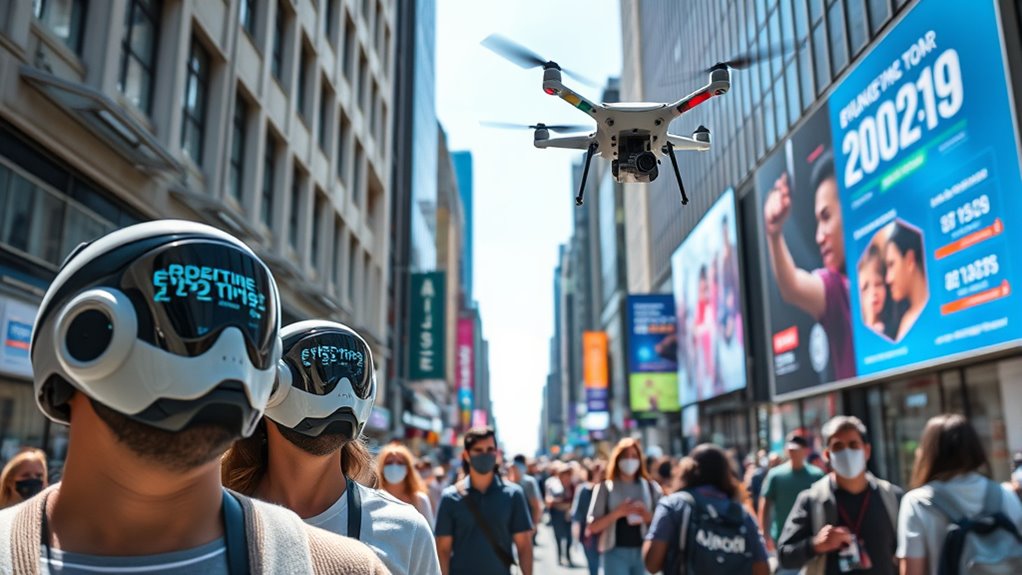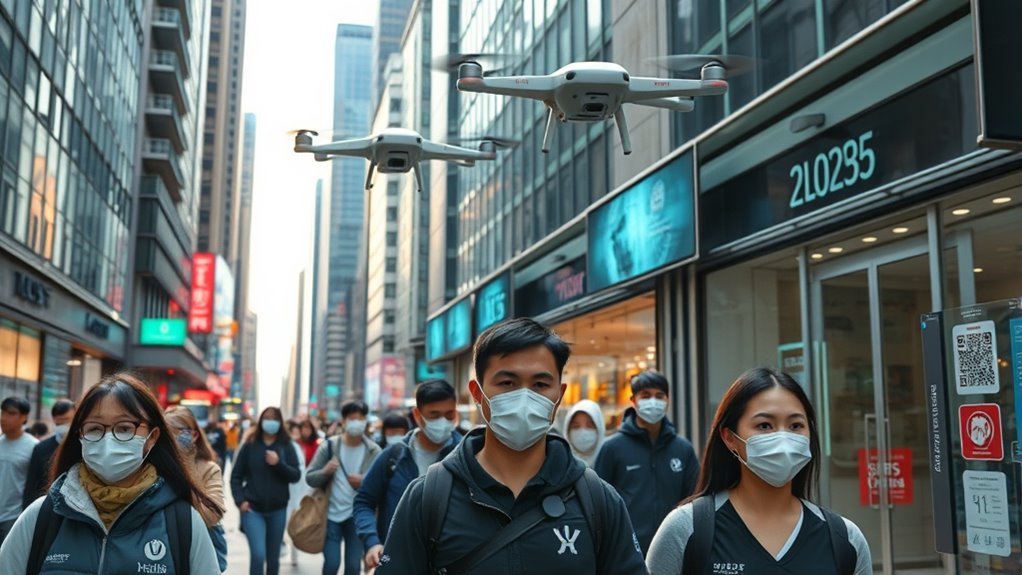By 2025, COVID-19 has become a routine part of life, thanks to widespread vaccination and better treatments. Vaccination campaigns have expanded, targeting vulnerable groups and boosting immunity with multiple doses and boosters. Improved logistics and digital tools make vaccine access easier while public health communications foster trust. Thanks to these efforts, hospitalizations have dropped, restrictions eased, and communities now focus on living with the virus. Discover how these strategies continue to shape our daily lives.
Key Takeaways
- COVID-19 has become a routine part of daily life, with milder symptoms due to advanced vaccines and treatments.
- Vaccination campaigns are widespread, focusing on equitable access and booster doses to counter new variants.
- Public health efforts now emphasize maintaining herd immunity rather than emergency responses.
- Digital tools and transparent communication enhance vaccination coverage and public trust.
- Travel restrictions and school closures have largely eased as vaccination success stabilizes pandemic management.

By 2025, COVID-19 has become a part of everyday life, but thanks to advances in vaccines and treatments, most people experience milder symptoms and fewer disruptions. One of the key factors in managing the pandemic now is the ongoing vaccine distribution efforts. Governments and health organizations have prioritized equitable access, ensuring vulnerable populations receive vaccines first, while also expanding availability to the general public. This widespread distribution helps reduce the severity of outbreaks and protects those at higher risk. You’ve likely seen how vaccination campaigns are seamlessly integrated into community health centers, pharmacies, and mobile clinics, making it easier than ever for individuals to get boosted or vaccinated for the first time. The focus has shifted from emergency response to maintaining herd immunity, which is essential for public health stability.
Vaccine distribution has become more streamlined, thanks to improved logistics, international cooperation, and technological innovations. Digital platforms now facilitate appointment scheduling, track vaccine inventories, and monitor coverage rates in real time. This transparency builds public trust and encourages more people to get vaccinated. Public health authorities have also adapted their strategies based on data, targeting areas with lower vaccination rates to prevent outbreaks. As a result, communities once vulnerable to surges now experience fewer hospitalizations and deaths. You might notice that vaccination rates are higher than ever, with most adults having received multiple doses, including booster shots designed to counter new variants. Additionally, the use of high-quality projectors for healthcare facilities enhances communication and education efforts about COVID-19 safety measures and vaccination benefits.
Streamlined vaccine distribution boosts trust and coverage, reducing hospitalizations and saving lives.
This focus on vaccination has directly impacted public health by reducing the strain on healthcare systems. Hospitals no longer face the overwhelming patient loads of early pandemic days, allowing staff to focus on other health concerns. The reduced severity of COVID-19 cases means fewer disruptions to daily life—schools are open, workplaces function normally, and travel restrictions are less common. Public health campaigns continue to promote vaccination as a key tool, emphasizing its role in protecting loved ones and communities. You’re also encouraged to stay informed about new booster recommendations, especially as the virus evolves.
In essence, the way vaccine distribution is managed today has transformed the pandemic from a crisis of emergency to a manageable aspect of public health. It exemplifies how science, logistics, and community effort come together to protect lives and restore stability. As you move through 2025, it’s clear that vaccination remains central to controlling COVID-19, helping everyone live with it rather than be overwhelmed by it.
Frequently Asked Questions
How Have COVID-19 Variants Changed Since 2024?
Since 2024, COVID-19 variants have continued to evolve through viral mutation, leading to new strains. You’ll notice changes in variant prevalence, with some becoming more dominant while others decline. These mutations often impact transmissibility and vaccine effectiveness, prompting ongoing adjustments in public health responses. Staying updated on the latest variants helps you better understand how the virus adapts and what measures remain essential for protection.
What New Treatments Have Emerged in 2025?
In 2025, you’ll find that antiviral advancements have led to more effective medications that reduce recovery time and severity. Immune therapies, like monoclonal antibodies and personalized vaccines, now offer targeted protection, especially for high-risk groups. These treatments are less invasive and more accessible, giving you better options to manage COVID-19. Staying updated on these innovations helps you make informed decisions and stay protected against new variants.
How Is COVID-19 Affecting Global Economic Recovery?
You see COVID-19 still impacting global economic recovery by challenging economic resilience and disrupting global trade. Supply chain issues persist, causing delays and increased costs, while consumer confidence fluctuates. Governments and businesses adapt by boosting digital infrastructure and diversifying supply sources. These efforts help stabilize economies, but ongoing health concerns require continuous vigilance to support sustained growth and resilience in the face of future disruptions.
Are There New Vaccination Strategies This Year?
Yes, new vaccination strategies are underway this year. You’ll find that vaccine distribution has become more streamlined, reaching more communities quickly. Booster campaigns are now more targeted, focusing on vulnerable populations and emerging variants. These strategies aim to boost immunity and curb transmission effectively. With improved logistics and updated vaccines, you’ll notice a more proactive approach to managing COVID-19, helping you stay protected and reducing the pandemic’s impact.
What Are the Long-Term Health Impacts Observed in 2025?
In 2025, you’ve likely noticed long-term health impacts like persistent fatigue and mental health challenges. Chronic fatigue remains common, affecting daily activities, while mental health issues such as anxiety and depression have increased for many. These effects are ongoing, emphasizing the importance of continued research and support. Staying proactive with healthcare, mental wellness, and lifestyle adjustments can help you manage these long-term impacts effectively.
Conclusion
As you look ahead to 2025, it’s clear COVID-19 has become part of our new normal, much like a never-ending episode of “The Twilight Zone.” While vaccines and treatments have advanced, the virus still surprises us, reminding you that history’s lessons aren’t always linear. Stay vigilant, adapt, and remember that even in a post-pandemic world, your actions shape tomorrow’s story. Don’t let this be a plot twist you didn’t see coming.










